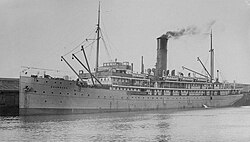Koombana (ship)
|
||||||||||||||||||
|
||||||||||||||||||
|
||||||||||||||||||
|
||||||||||||||||||
The Koombana was a passenger ship put into service in 1909 by the Australian shipping company Adelaide Steamship Company, which transported passengers , mail and cargo in a regular service from Adelaide in the Australian state of South Australia to various ports in Western Australia . On March 20, 1912, the steamer north of Port Hedland on the coast of the Pilbara region was sunk by a cyclone that struck the coastal area of Western Australia, destroyed many ships and killed more than 150 people. None of the 138 passengers and crew on board survived. The sinking of the Koombana is the worst weather-related shipwreck in Australia in the 20th century. The wreck of the Koombana is still undiscovered today.
The ship
The 3,668 GRT passenger and cargo steamer Koombana was built in 1908 in the Linthouse district of Glasgow on the River Clyde by the renowned Alexander Stephen and Sons shipyard. Their hull was made of iron . In December 1908 the ship was completed. The owner of the Koombana was the Adelaide Steamship Company, an Australian shipping company founded in 1875 and based in Adelaide, where the ship was also registered. In her day she was one of the largest ships in the shipping company .
The Koombana called at port cities such as Fremantle , Derby , Broome and Wyndham . On March 15, 1909, she was stranded on a sandbar in Shark Bay . Following the tradition of the shipping company, the ship was named after a word from the Aboriginal language . In this case it was koombana , which can be translated as "place of the whales", but also as "calm and peaceful". The Bay Koombana Bay near the city of Bunbury so got its name.
The disappearance
On Wednesday morning, March 20, 1912, the Koombana left Port Hedland for a crossing to Broome. Captain Thomas M. Allen was in command. There were 138 passengers and crew on board . Since there were no accurate passenger lists, it is possible that the number of people also differed. Some sources state that there were 150 people on board. It followed directly the Bullarra , which also belonged to the Adelaide Steamship Company and, like the Koombana, was used in passenger and freight traffic in the northeastern waters of Australia. There were steady winds from the northeast.
Before casting off, Captain Allen noticed that the barometer had fallen and he noted that the crossing would probably take longer than normal. The two ships followed a common course for several hours until suddenly strong winds from the northeast set in and separated them. The Bullarra suffered damage, but managed to escape to the port of the small town of Cossack on its own. From then on there was no trace of the Koombana .
A cyclone in the next to the Koombana many more ships like the Norwegian steamer Crown of England sank and others, like the Welsh Bark Concordia , ran aground , had ravaged the coast. Two days later, on March 22, 1912, the cyclone crossed the coast near the village of Balla Balla. A stretch of coast more than 200 km long had been devastated. In addition to the people on board the Koombana , another 11 to 15 people died from the cyclone. According to other sources, he claimed up to 60 more lives.
When the ship did not enter Broome, they became concerned and a search was organized. On April 3, 46 km north of Bedout Island and 100 km from the coast, one of the search ships encountered debris and wreckage, including a lifeboat , sofa and cabin door. The ship itself and the people on it were gone. Not a single body was ever discovered; the wreck has not been found either. Exactly how the accident happened could never be clarified as there were no surviving eyewitnesses.
In 1973 , what was believed to be the remains of a large ship was found 23 miles north of Eighty Mile Beach , about halfway between Port Hedland and Broome. In 1985, the crew of a Lockheed P-3 of the Royal Australian Air Force found a significant magnetic anomaly on the ocean floor 75 km north of Bedout Island using a Magnetic Anomaly Detector (MAD) . To date, however, no direct search has taken place.
The Roseate Pearl
Abraham de Vahl Davies (1864-1912), a wealthy Jewish entrepreneur and former pearl merchant from Broome and uncle of the racing driver Bernard Rubin , was on board the Koombana . Davies had recently bought the so-called Roseate Pearl , a famous black Akoya pearl , for £ 20,000 and taken it aboard the ship.
Legend has it that it was considered cursed as many of its previous owners had committed suicide, were murdered, or died of heart attacks . Davies is said to have haunted the Bishop's Palace in Broome as an apparition until the building was demolished in 1980.
literature
- Ion Llewellyn Idriess. Forty Fathoms Deep . Angus & Robertson (Sydney), 1937
- John Bailey. The White Divers of Broome . Pan Macmillan Australia (Sydney), 1944
- Bill Beatty. A Treasury of Australian Folk Tales and Traditions . Edmund Ward (London), 1960
Web links
- Information about the Koombana and their disappearance
- Summary of the disappearance of the Koombana
- The Koombana in the National Shipwrecks Database (tabular list)
- Overview of tropical storms in the Pilbara region
- Entry in the Miramar Ship Index
- 130 LOST WITH STEAMER ( New York Times report , April 4, 1912)



